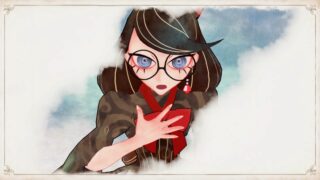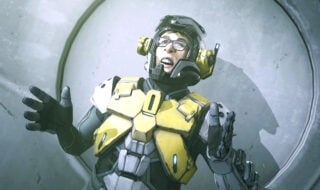Inspired by a Dreamcast obscurity, PSVR2’s C-Smash still oozes futurism
RapidEyeMovers’ retro revival somehow manages to feel thoroughly forward-looking and futuristic

Given the current vogue for remakes of old classics, the phrase “labour of love” is probably a tad overused in the context of video games at the moment. However, there’s no way to get around it: C-Smash VRS, a launch-window game for the PSVR2, is the very definition of a labour of love.
C-Smash VRS (as the name hints) is the result of a 23-year obsession held by developer-publisher Jörg Tittel with one of the most obscure games ever: a Dreamcast game released by Sega in 2000 called Cosmic Smash.
At the time Tittel (currently one of the hardest-working men in games development as he and co-developer Wolf & Wood also put the finishing touches to The Last Worker, published by Wired Productions) was a journalist, working for Official Dreamcast Magazine in New York.
Cosmic Smash was actually released after the Dreamcast had been discontinued, but its irresistibly design-led orange packaging (it was one of the few Dreamcast games not to be sold in a jewel case) and weird squash meets Breakout on a space-station aesthetic meant Tittel felt he had to acquire a copy.
Sony’s PSVR2 headset provided Tittel with the perfect medium for his reimagining of Cosmic Smash, and we got some hands-on time with C-Smash VRS at a preview event in central London. Helpfully, we also managed to play a rare example of Sega’s arcade version of Cosmic Smash, which confirmed that C-Smash VRS stays true to the spirit of the original game, albeit in a thoroughly modern manner.
Thus, C-Smash VRS is also essentially a form of squash enacted on a space-station – in surroundings with a satisfyingly futuristic design aesthetic, and with virtual stars and planets visible through its windows.
Dressed in a virtual jumpsuit, you must hit an orange ball against Breakout-like pads, often arranged in layers in front of and behind each other (so, if you find a sweet spot, you can send the ball bouncing between them, taking out several at a time).
One of the PSVR2’s controllers operates as your paddle or racket and, as in the original game, you must use the joystick on the other to move left and right (you’re always hitting the ball into the screen). There’s a special move that lets you hit an overhead smash – vital when the ball is bouncing up above your head.

We only played the single-player mode, but you will also be able to play one versus one or two-player co-op versus the AI – in both instances locally or online. In other words, it’s a pretty simple squash-like VR game, but vibe-wise, it’s mightily impressive.
It’s simply beautiful to behold, in a manner that brings to mind the design-led nature of the likes of WipEout, and its zen-like air is enhanced by strikingly atmospheric music.
Tittel was keen to emphasise that right from the start of the development process, he felt compelled to involve the renowned visual designers Cory Schmitz and Arkotype, and that the music, provided by techno stalwart Ken Ishii and up-and-coming London electronic artist Danalogue is also a vital component of the game.
Jörg Tittel on making C-Smash VRS
What Tittel has come up with is the type of VR game that offers a degree of catharsis – or at the very least relaxation – after a hard day’s toil or the like. Like squash, it gives you a chance to work off a bit of aggression, albeit without the need to flog yourself physically.
Tittel told VGC that C-Smash VRS’s original roots –fuelled by both his unquenchable love of all things Sega and fascination with the possibilities of VR — long predate the release of Cosmic Smash=.
“I fell in love with OutRun in 1986 when I stepped into an arcade cabinet and it shook me about physically, and that put me on this ride which wasn’t about competition – it was about travelling somewhere, and having a beautiful experience. Ever since then, I’ve associated that feeling with Sega – whenever Sega brought that feeling back in different forms, I’ve felt alive, and I’ve felt happy. That spoke to the inner child in me.
“Despite the death of the Dreamcast, out of that dark time came so many great, iconic ideas, projects and concepts. This was the one which came after that tragic end, but it refused to just go out with a whimper, because it was so iconic in its packaging and everything else. And I always associated Sega with being way ahead of its time.
“It was the first company that wanted me to get into VR, back in 1993, when it showed off its Mega Drive-powered – or underpowered – headset at CES, which ended up not coming out. So I’ve always wanted to make this for VR, and here we are.”
“Without Sega, none of us would have had VR – it’s not Oculus that invented VR, it’s Sega – they already had VR arcade cabinets in the early 90s”
So, right from the start, graphic design was a huge element? “Yes: I wanted it to be graphic design made physical, so the first people I talked to about this project were Corey Schmitz and Arkotype. I thought if I’m going to do this right, I’m going to have to understand the aesthetic, really do my homework and create a design bible for the project. And then it was also very important for me to work with designers who could think physically as well.”
So how did Tittel set about converting a Dreamcast game into a cutting-edge slice of PSVR2 modernity, with PvP and co-op modes? “The full game already had big dreams, but it was so out-of-the-box unusual that you would have to perfectly make your way through a single player-journey in order to face off against another character.
“It was almost like an Easter egg: they kept the two-player mode as an Easter egg, but it was AI-driven. So it was always in its DNA to become more than a one-player game, but they just didn’t have the budget, scope and so on to go there.
“Then also the cosmonauts – the guys in the white jumpsuits – only appeared in the end-credits in the original game. I love the fact that at the core of this, of what some might think of as a cold design-world, that actually you have these very human, goofy characters hanging out, and hanging out in clothing that you would usually associate with work. So even when they’re working, they’re having a great time.”

C-Smash VRS – with a demo version due for a March 23 release – is perfectly timed to hit the PSVR2 launch window, and in The Last Worker, Tittel has another game which operates on the PSVR2.
Does he feel that Sony’s PSVR2 is some sort of spiritual successor to the sort of hardware that might have been made by his beloved Sega? “Without Sega, none of us would have had VR – it’s not Oculus that invented VR, it’s Sega – they already had VR arcade cabinets in the early 90s, and there was OutRun, which feels like VR when you’re sitting inside that Ferrariesque vehicle.
“I think Sony are incredible people to work with, genuinely: they’ve provided great development support. Sony is also the one corporation out there that is not about stealing data from you: it’s about making beautiful objects. its design language has been stunning throughout its history. Also, it’s a tech company that has come from a cultural standpoint, and has always stayed at the heart of it. I have nothing but love for Sony.”
Given his depth of love and respect for the company, it may seem slightly strange that Sega itself isn’t publishing C-Smash VRS, but instead Tittel’s company RapidEyeMovers is self-publishing the game. Obviously, Sega has been involved at a licensing level, but Tittel decided that self-publishing provided the best means of retaining full creative control.
“If I was going to be published by anyone, it would be Sega, but I’m an indie in spirit through and through and jumped at the chance to publish the game through our new label, RapidEyeMovers. C-Smash VRS is only the beginning – but we have an exciting roadmap planned for this game alone. Like the universe itself, C-Smash VRS has been designed from the ground up to stretch and expand.”
Danalogue: first game-music foray of many?
We also interviewed Danalogue, the London-based synth wizard who composed much of C-Smash VRS’s music. Like Tittel, he has many projects on the go, including two bands: “One of the bands is called the Comet Is Coming. It’s very cosmological – it’s kind of like an imagined apocalypse, but very inspired by a love of all things cosmic, macrocosmic perspectives, and space and sci-fi.
“My other band is called Soccer 96 which is named after a computer game, and all my synths are old Roland analogues like the Juno, SH-101, SH-09 and 808 drum machine. I actually use a lot of sonic palettes where people thought I was making computer game music already. So I make cosmic, computer game-sounding music anyway.”
Danalogue outlines his creative aims when composing C-Smash VRS’s music; his entry point was: “World-building, more than anything else. I got into the idea of what a civilisation would have to have achieved to build a space station and to be playing sport on it. Then I thought: well, they seem to be pretty evolved as well. They must have reached some level of spiritual attainment, or at least managed to avoid some of the trappings of our baser instincts.

“I was trying to write a new kind of music that was propulsive and energetic, and sounded like an athletic sound with drum machines and so on, but I wanted to bring in something that almost romanticised it, and signified a spiritual world, as well.
“I sampled voices a lot and used a lot of choir sounds. I also wanted to use a lot of high-frequency synth stuff to replicate maybe looking at the stars through the windows of the game, so you’ve got a lot of these glistening high-frequency sounds.”
The Comet Is Coming, in particular, have been developing a sizeable and enthusiastic following recently. Their 2016 debut album, Channel the Spirits, was nominated for the Mercury Prize, and on the back of last year’s album Hyper-Dimensional Expansion Beam, they are poised to spend March 2023 touring throughout the UK and Europe.
Meanwhile, C-Smash VRS, with its melding of music, graphic design and forward-looking VR gameplay, harks back to the sort of pop-culture fusions that created such excitement during the early days of the original PlayStation and the Dreamcast.
But while it may have been nominally inspired by a lost retro classic, it somehow manages to feel thoroughly forward-looking and futuristic. If you have a PSVR2, you’d be a fool not to get a taste of it by downloading the March 23 demo version.












